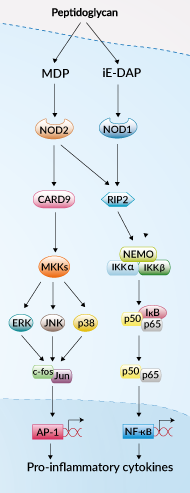NOD-Like Receptors
InvivoGen provides an extensive list of tools to study NOD1 and NOD2
Nod-like receptors (NLRs) constitute a family of intracellular pattern recognition receptors (PRRs), which contain more than 20 members in mammals. Their founding members are the Nucleotide-binding Oligomerization Domain-containing proteins NOD1 and NOD2, also known as NLRs, CATERPILLERs, or NALP/PAN/PYPAFs.
These cytosolic PRRs are specialized to sense distinct motifs of peptidoglycan (PGN), an essential constituent of the bacterial cell wall. NOD1 senses the D-γ-glutamyl-meso-DAP dipeptide (iE-DAP), which is found in the PGN of all Gram-negative and certain Gram-positive bacteria. NOD2 recognizes the muramyl dipeptide (MDP) structure found in almost all bacteria, acting as a general sensor of bacterial invasion.
InvivoGen offers a large set of tools
- NOD reporter cells
- NOD ligands (agonists and antagonists)
- fully sequenced NLR and related genes.
Key features of InvivoGen's products
- Each lot is functionally tested
-
Guaranteed free of unwanted bacterial contaminants
During the last few years, NOD1 and NOD2 have attracted significant attention from scientists. Genetic mutations in NOD2 were recently associated with Crohn’s disease, a chronic inflammatory bowel disease. Moreover, numerous studies have lately revealed that NOD1 and NOD2 have a close relationship with a variety of cancers via controlling proliferation, altering immunosurveillance, and interacting with tissue bacteria, including intestinal commensal intestinal microflora. Moreover, additional research into the mechanisms of NOD1 and NOD2 in cancers would shed light on the innate immunity-cancer relationship and provide intriguing targets for immunotherapy.
![]() Read our review on NOD-Like Receptors
Read our review on NOD-Like Receptors
➔ Everything around the NLRP and NLRC inflammasomes, you can find here.





